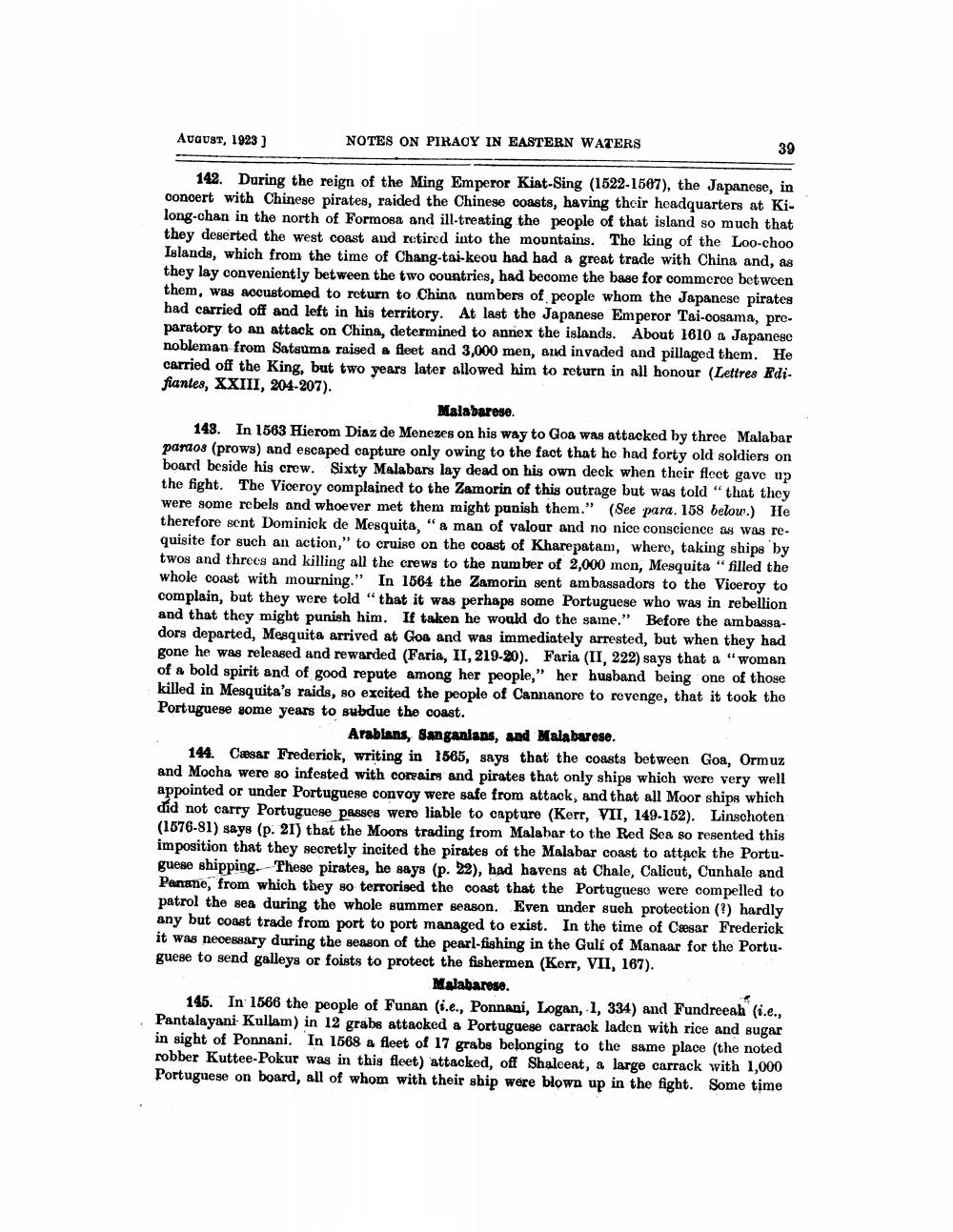________________
August, 1923)
NOTES ON PIRACY IN EASTERN WATERS
39
142. During the reign of the Ming Emperor Kiat-Sing (1522-1507), the Japanese, in concert with Chinese pirates, raided the Chinese coasts, having their headquarters at Kilong-chan in the north of Formosa and ill-treating the people of that island so much that they deserted the west coast and retired into the mountains. The king of the Loo-choo Islands, which from the time of Chang-tai-keou had had a great trade with China and, as they lay conveniently between the two countries, had become the base for commerce between them, was accustomed to return to China numbers of people whom the Japanese pirates had carried off and left in his territory. At last the Japanese Emperor Tai-cosama, preparatory to an attack on China, determined to annex the islands. About 1610 a Japanese nobleman from Satsuma raised a fleet and 3,000 men, and invaded and pillaged them. He carried off the King, but two years later allowed him to return in all honour (Lettres Edifiantes, XXIII, 204-207).
Malabarese. 148. In 1563 Hierom Diaz de Menezes on his way to Goa was attacked by three Malabar pardos (prows) and escaped capture only owing to the fact that he had forty old soldiers on board beside his crew. Sixty Malabars lay dead on his own deck when their fleet gave up the fight. The Viceroy complained to the Zamorin of this outrage but was told "that they were some rebels and whoever met them might punish them." (See para. 158 below.) He therefore sent Dominiok de Mesquita, "a man of valour and no nice conscience as was requisite for such an action," to cruise on the coast of Kharepatam, where, taking ships by twos and threes and killing all the crews to the number of 2,000 men, Mesquita "filled the whole coast with mourning." In 1564 the Zamorin sent ambassadors to the Viceroy to complain, but they were told that it was perhaps some Portuguese who was in rebellion and that they might punish him. If taken he would do the same." Before the ambassadors departed, Mesquita arrived at Goa and was immediately arrested, but when they had gone he was released and rewarded (Faria, II, 219-20). Faria (II, 222) says that a "woman of a bold spirit and of good repute among her people," her husband being one of those killed in Mesquita's raids, so excited the people of Cannanore to revenge, that it took the Portuguese some years to subdue the coast.
Arablans, Sanganlans, and Malabarese. 144. Cæsar Frederick, writing in 1565, says that the coasts between Goa, Ormuz and Mocha were so infested with corrains and pirates that only ships which were very well appointed or under Portuguese convoy were safe from attack, and that all Moor ships which did not carry Portuguese passes were liable to capture (Kerr, VII, 149-152). Linschoten (1676-81) says (p. 21) that the Moors trading from Malabar to the Red Sea so resented this imposition that they secretly incited the pirates of the Malabar coast to attack the Portuguese shipping. These pirates, he says (p. 22), had havens at Chale, Calicut, Cunhale and Panane, from which they so terrorised the coast that the Portuguese were compelled to patrol the sea during the whole summer season. Even under such protection (?) hardly any but coast trade from port to Port managed to exist. In the time of Cesar Frederick it was necessary during the season of the pearl-fishing in the Gulf of Manaar for the Portuguese to send galleys or foists to protect the fishermen (Kerr, VII, 167).
Malabarese. 145. In 1566 the people of Funan (i.e., Ponnani, Logan, 1, 334) and Fundreeah (i.e., Pantalayani Kullam) in 12 grabs attacked a Portuguese carrack laden with rice and sugar in sight of Ponnani. In 1568 a fleet of 17 grabs belonging to the same place (the noted robber Kuttee-Pokur was in this fleet) attacked, off Shaloeat, a large carrack with 1,000 Portuguese on board, all of whom with their ship were blown up in the fight. Some time




